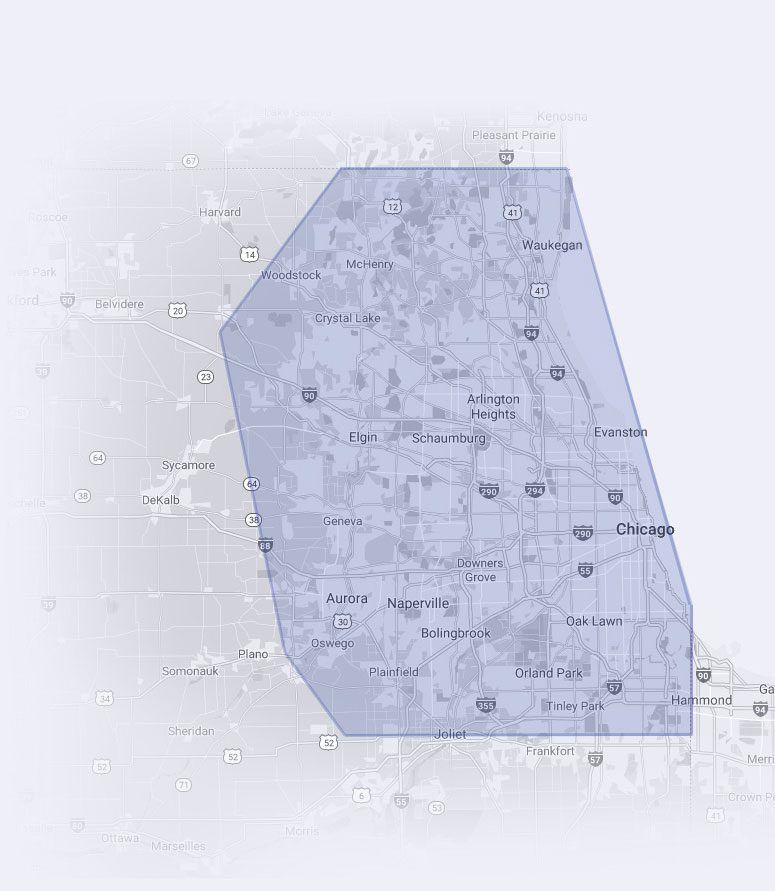If you are noticing uneven, cracked, or sinking concrete surfaces on your property, it is potentially an indication that you need concrete leveling. At The Real Seal, we offer tailored concrete leveling services to restore concrete slabs on your property. We utilize industry-standard repair techniques and high-quality materials to fix settling concrete surfaces, including patios, pool decks, sidewalks, garage floors, or driveways. Our solutions are durable, quick, and minimally invasive. Get started with us today for efficient concrete leveling solutions. Give us a call to schedule a free inspection.
What Is Concrete Leveling?
The area of Chicago Illinois is subject to many different weather-related issues. These include periods of heavy rain and the freeze/thaw cycle that may happen many times during the winter. Either could affect the soil and cause concrete to sink.
Concrete leveling is the process that raises a concrete slab, such as a driveway, sidewalk, or stairs up to its original level. It is done using injecting polyurethane foam under the concrete, a process known as polyjacking.
As the polyurethane foam expands, it compresses the soil and raises the slab. It sets within a few minutes to full strength, so you can begin walking, driving, and otherwise using the slab as before.

Does Concrete Leveling Work?
Concrete leveling has been done in some form or another for decades. At The Real Seal, we use the most up-to-date and reliable method of slab jacking, polyurethane foam (polyjacking).
As a short answer, Yes! Concrete leveling works. As long as the concrete is in good condition, it can often be raised to its original level without causing any damage to the slab. You can then begin using it within 15 minutes.
You may hear of other concrete leveling options, including mudjacking and replacing the slab but neither of those comes close to polyjacking. Since Polyurethane foam began being used decades ago, it quickly became the go-to option for concrete leveling because of its ability to lift concrete and hold it in place permanently.
When Do You Need Concrete Leveling?
Having a level concrete surface on your driveways, walkways, and patios is more than just a matter of aesthetics. If the slab has sunk or settled, it can cause tripping hazards or can even permanently damage the slab by cracking it.
An uneven surface is the most common reason why you might need concrete leveling but it is not the only reason. If you have water in the basement, there may be benefits to leveling the concrete slab as well.
Any time there is an issue with the soil under the slab, the leveling process will be of benefit. Polyurethane foam fills the voids and, if the slab has settled, it will lift it back into place.
Concrete Leveling Methods
The Real Seal uses polyjacking as our form of slabjacking. There are other methods, and they each have their place, but typically, you would compare mudjacking and polyjacking. Here are the differences to be aware of.
Mudjacking
Mudjacking has been in use for over 100 years and some companies still offer this service. It may still have its place, but it is an outdated option that has since been replaced with polyjacking.
The process of mud jacking starts with drilling holes in the concrete. These holes are larger than what is drilled for polyjacking. They are used for injecting the slurry of soil, sand, and concrete under the slab. The force of the injection pushes the mud underneath the surface and lifts the concrete.
Mudjacking can lift concrete but it is not very long-lasting. There are also possible problems associated with it, as it is harder to control the lift and requires larger holes. It may require a day before any heavy use of the slab is considered.
Polyjacking
The top choice for concrete lifting is polyjacking. It uses polyurethane foam to lift the slab back to an acceptable level. The polyurethane is a 2-part mixture that is injected below the slab through small, dime-sized holes.
Once the liquid is in the void below the concrete, it expands 30-50 times its liquid size. As it does so, it fills the void and compresses the soil, while at the same time, lifting the concrete.
Polyurethane foam has a long lifespan and is both lightweight and non-toxic. It also has the benefit of being able to be used within minutes after the work is done.
We Offer Concrete Leveling Using Polyjacking Near You in Chicago, Illinois
You can count on The Real Seal Basement Waterproofing and Foundation Repair to provide the best concrete leveling services in Chicago and the surrounding area. We have years of experience with a wide range of repairs that affect your home, including foundation stabilization, concrete crack repair, and polyjacking.
Simply fill out the form on our website and one of our industry experts will get back to you promptly. Thousands of Illinois residents have trusted us with their concrete leveling needs. We look forward to taking care of your needs as well.
Types of Concrete Leveling The Real Seal Offer
Patios
Driveways
Pool Decks
Sidewalks
Foundations
Concrete Steps
Porches
Garage floors
The Real Seal’s Polyjacking Process in Chicago
Polyjacking is a relatively straightforward process that involves injecting polyurethane foam under a slab and forcing it to rise as the foam expands. The following are the steps associated with the process.
1. Drill Holes:
Dime-sized holes are drilled through the concrete to allow access for the polyurethane to be injected into the void below the slab.
2. Crack Repair (Optional):
If the concrete has cracked and settled, we may need to grind the concrete at the crack so it doesn’t keep the slab from lifting effectively.
3. Manual Lifting (Optional):
A sidewalk jack may be used in some cases to get the lift started and to create a void where the polyurethane is injected.
4. Foam Injection:
An injection port is inserted into the hole we drilled in the concrete. We then use an injection foam gun to inject the liquid polyurethane mixture into the void below the slab.
5. Lift:
The polyurethane foam begins to expand rapidly. As it does, it fills the void below the concrete and begins lifting the slab. The foam expands up to 50 times its original volume. This process is done by an experienced technician so the slab is lifted into place precisely.
6. Fill:
7. Clean Up:
Any additional polyurethane foam is scraped away. We then clean up the area so that, after we are gone, you are left with a level slab and it looks like we were never there.
Benefits of Polyjacking
Polyjacking offers many benefits compared to other forms of concrete lifting or repair, including mudjacking or replacing the slab. Those benefits also stand on their own. They include:
One of the main reasons people consider polyjacking is because of the high cost associated with removing the old slab and pouring a new one.
Mudjacking uses a larger hole, which may be 2" in diameter. Polyjacking is done through a small hole with a tapered injection port. The hole size typically used for polyjacking is 5/8".
Polyurethane foam only weighs about 2 pounds per cubic foot, yet it has the ability to hold up significant weight.
Polyurethane is non-toxic. Once it hardens in place, it will not have a negative impact on the environment.
Polyurethane foam can be injected and within 15 minutes, the slab can be used normally.
Why Choose Us for Concrete Leveling?
With years of reliable home improvement services, we have established ourselves as trusted concrete leveling repair professionals. Here are some of the benefits our services provide:
- Certified, well-trained experts: Our certified professionals have undergone extensive training, specializing in various basement and foundation repair solutions. Through years of service, they have honed their expertise and have handled a variety of concrete leveling projects with excellence.
- Industry-leading solutions: We keep up with the latest upgrades in the industry and update our repair solutions accordingly, ensuring effective and lasting results.
- Efficient project completion: We carefully plan every step of each project, ensuring maximum efficiency and timely project completion.
- Free estimate: Our free inspection service is designed to help our clients get an overview of the repair project by providing them with a free customized quote.
Contact Us for Concrete Leveling in Chicago, IL
Leaving sinking or uneven concrete surfaces unaddressed may cause tripping hazards. The Real Seal offers personalized concrete leveling solutions to fix any damaged concrete surfaces on your property. Get started with us by scheduling a free on-site evaluation. Our team will thoroughly assess your property, from concrete leveling issues to other solutions like crawl space encapsulation and converting crawl spaces to basements. We provide an accurate estimate and recommend suitable repair solutions. Contact us today to learn more.
Frequently Asked Questions

When should you get concrete leveling services?
You should consider getting concrete leveling services if the concrete surfaces on your property show the following signs of damage:
- Sinking
- Water pooling on concrete surfaces
- Voids forming under concrete slabs
- Uneven or cracked concrete surfaces

What is the best concrete leveling method?
Polyjacking is the most efficient concrete leveling method. This repair method lifts the concrete slab quickly with minimum disruption.

What is the cost of concrete leveling in Chicago, IL?
The cost of concrete leveling in Chicago depends on the type of concrete leveling service you need and the scope of the project. For an accurate quote, schedule a free inspection.

Is concrete leveling covered by insurance in Chicago, IL?
Concrete leveling may be covered by insurance depending on the cause of any damage. Check with your insurance service provider to learn more about the extent of your coverage.

Does The Real Seal provide a warranty on concrete leveling services?
Yes, we provide a 10-year warranty on every concrete leveling project. This is a longer warranty than most companies offer.



































